Association Between Physical Movement and Wellbeing: Interview Report
VerifiedAdded on 2022/12/26
|13
|3113
|69
Report
AI Summary
This report presents a qualitative research study investigating the association between physical movement and wellbeing among international students at Torrens University. The study employed a qualitative research design, based on phenomenology, using semi-structured interviews with four international students from diverse backgrounds. The interviews explored the participants' perceptions of physical activity's impact on their health and emotional wellness. Key themes emerged from the analysis, including the benefits of physical activity on health, the role of exercise in emotional wellbeing, barriers to participation (such as lack of motivation and social isolation), and the role of educational institutions in promoting physical activity. The findings suggest that while the participants generally recognized the positive impacts of physical activity, acculturation challenges and lack of institutional support acted as significant barriers. The report concludes with recommendations for educational institutions to address these barriers and promote physical activity among international students.
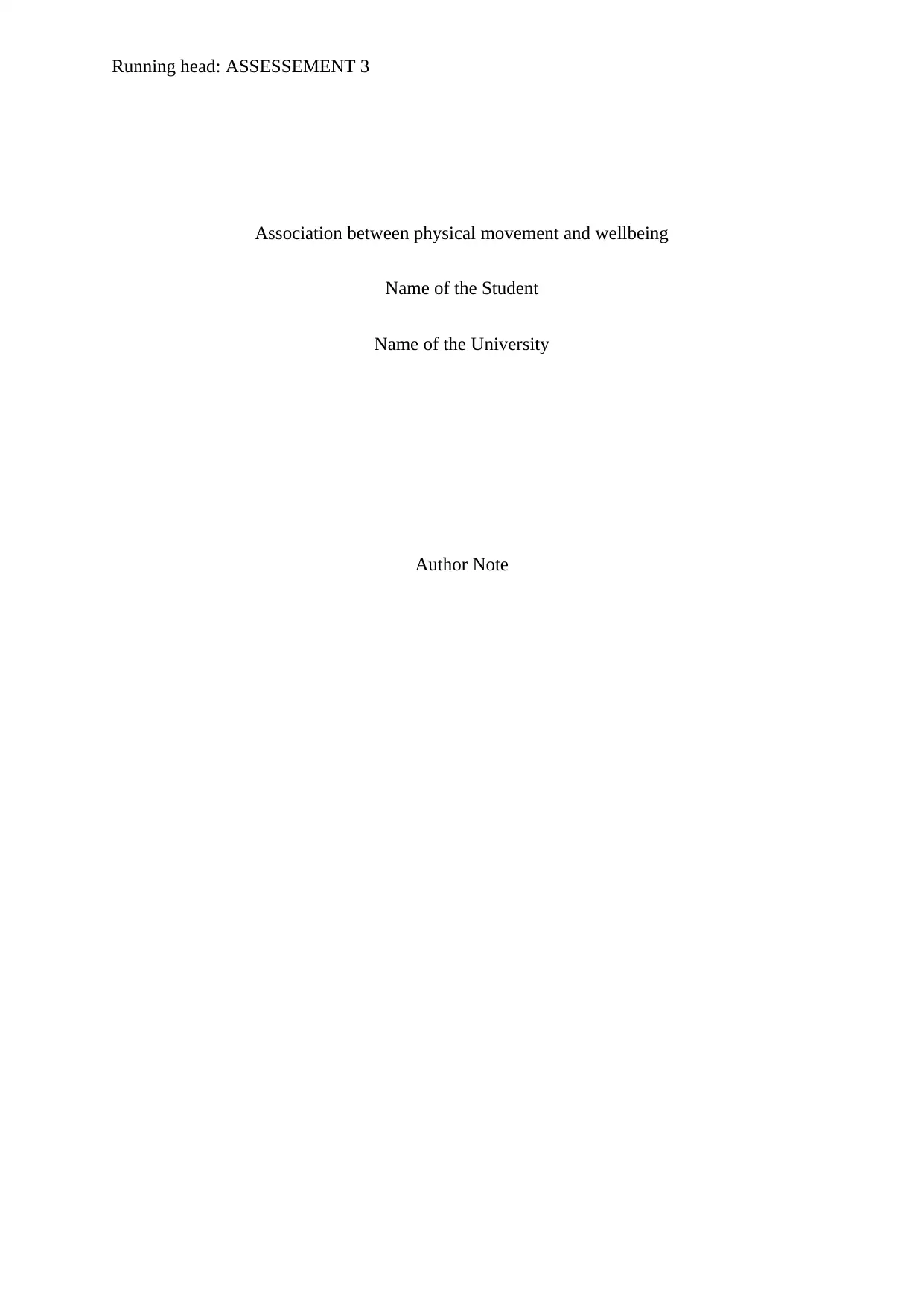
Running head: ASSESSEMENT 3
Association between physical movement and wellbeing
Name of the Student
Name of the University
Author Note
Association between physical movement and wellbeing
Name of the Student
Name of the University
Author Note
Paraphrase This Document
Need a fresh take? Get an instant paraphrase of this document with our AI Paraphraser
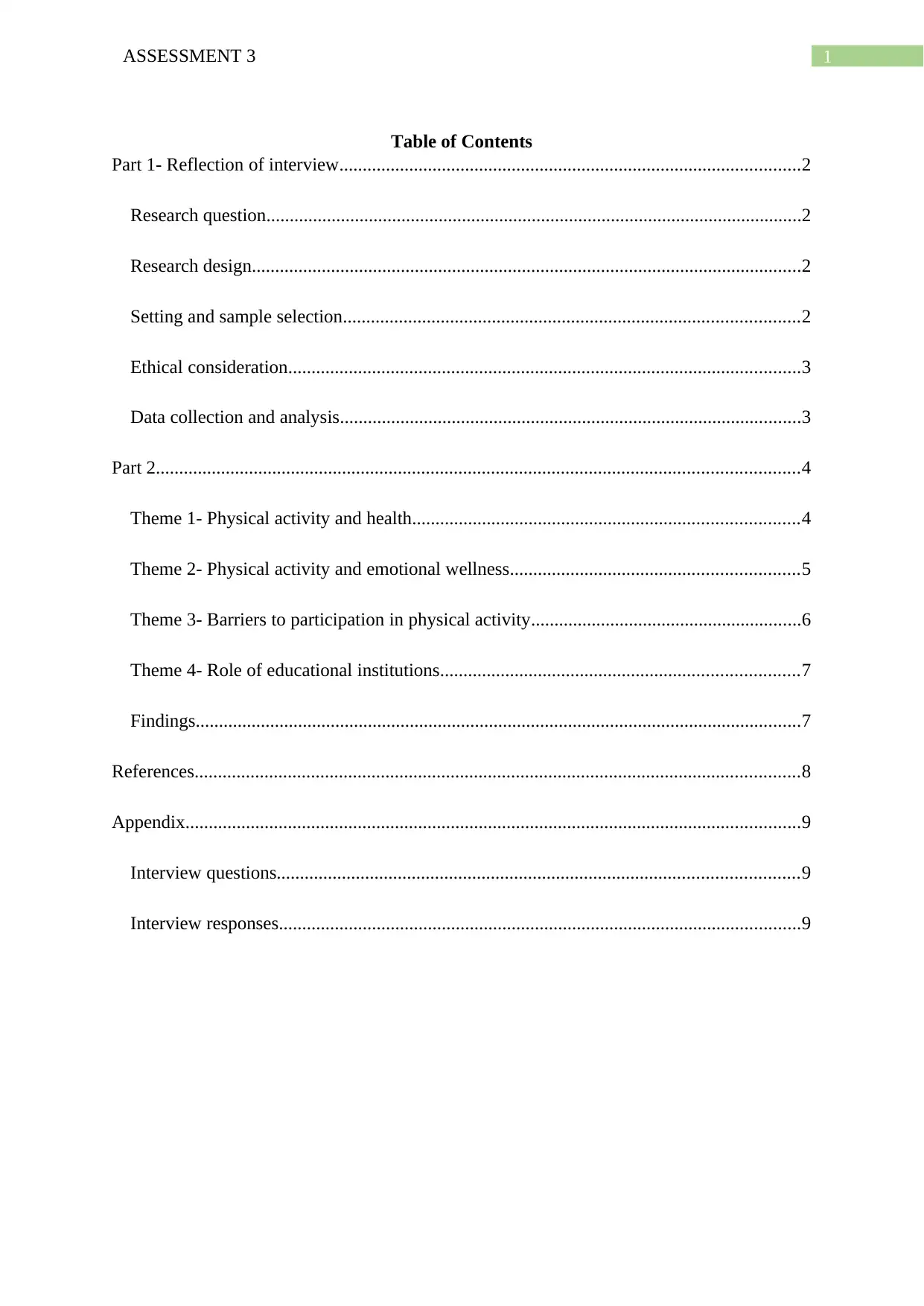
1ASSESSMENT 3
Table of Contents
Part 1- Reflection of interview...................................................................................................2
Research question...................................................................................................................2
Research design......................................................................................................................2
Setting and sample selection..................................................................................................2
Ethical consideration..............................................................................................................3
Data collection and analysis...................................................................................................3
Part 2..........................................................................................................................................4
Theme 1- Physical activity and health...................................................................................4
Theme 2- Physical activity and emotional wellness..............................................................5
Theme 3- Barriers to participation in physical activity..........................................................6
Theme 4- Role of educational institutions.............................................................................7
Findings..................................................................................................................................7
References..................................................................................................................................8
Appendix....................................................................................................................................9
Interview questions................................................................................................................9
Interview responses................................................................................................................9
Table of Contents
Part 1- Reflection of interview...................................................................................................2
Research question...................................................................................................................2
Research design......................................................................................................................2
Setting and sample selection..................................................................................................2
Ethical consideration..............................................................................................................3
Data collection and analysis...................................................................................................3
Part 2..........................................................................................................................................4
Theme 1- Physical activity and health...................................................................................4
Theme 2- Physical activity and emotional wellness..............................................................5
Theme 3- Barriers to participation in physical activity..........................................................6
Theme 4- Role of educational institutions.............................................................................7
Findings..................................................................................................................................7
References..................................................................................................................................8
Appendix....................................................................................................................................9
Interview questions................................................................................................................9
Interview responses................................................................................................................9
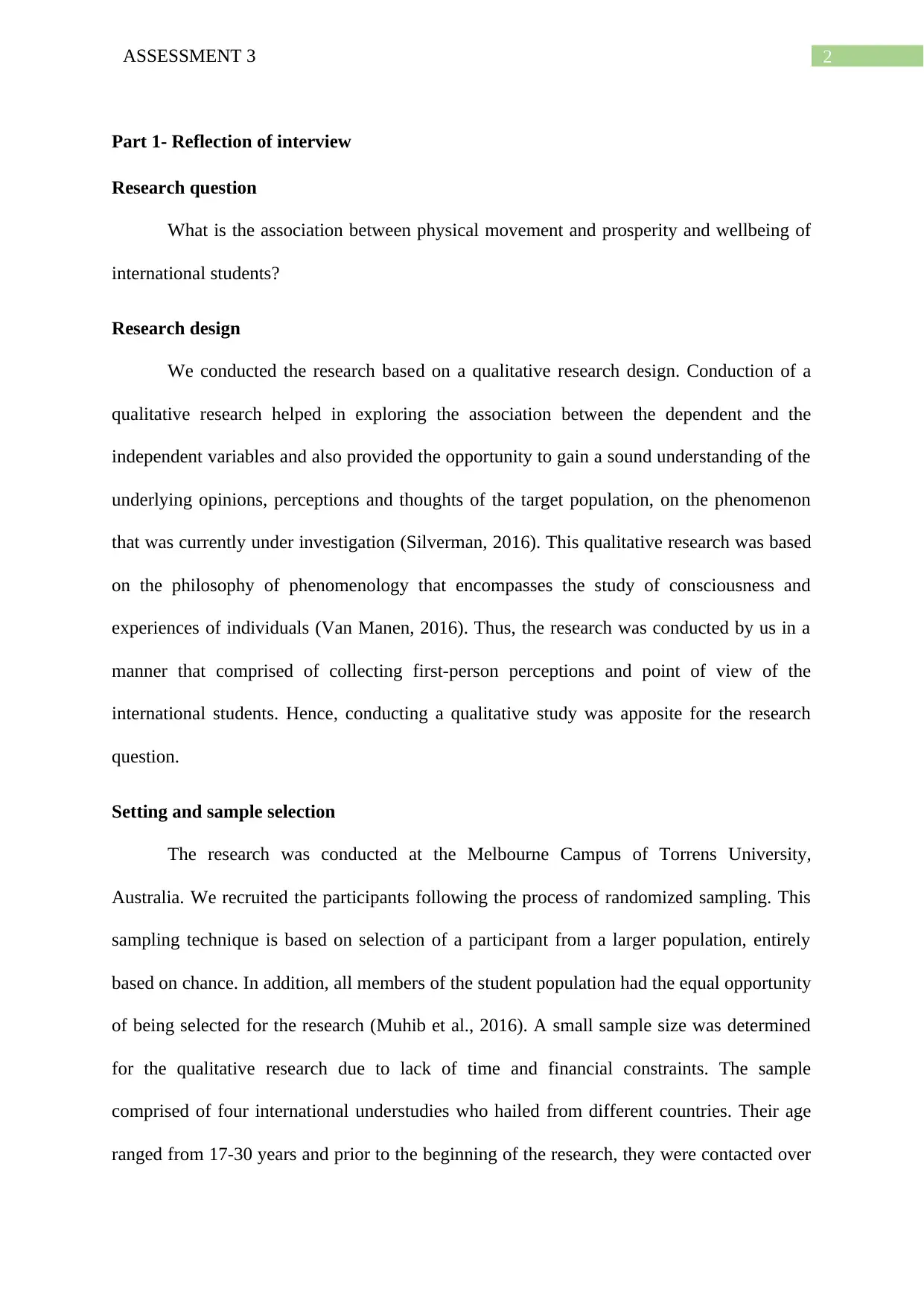
2ASSESSMENT 3
Part 1- Reflection of interview
Research question
What is the association between physical movement and prosperity and wellbeing of
international students?
Research design
We conducted the research based on a qualitative research design. Conduction of a
qualitative research helped in exploring the association between the dependent and the
independent variables and also provided the opportunity to gain a sound understanding of the
underlying opinions, perceptions and thoughts of the target population, on the phenomenon
that was currently under investigation (Silverman, 2016). This qualitative research was based
on the philosophy of phenomenology that encompasses the study of consciousness and
experiences of individuals (Van Manen, 2016). Thus, the research was conducted by us in a
manner that comprised of collecting first-person perceptions and point of view of the
international students. Hence, conducting a qualitative study was apposite for the research
question.
Setting and sample selection
The research was conducted at the Melbourne Campus of Torrens University,
Australia. We recruited the participants following the process of randomized sampling. This
sampling technique is based on selection of a participant from a larger population, entirely
based on chance. In addition, all members of the student population had the equal opportunity
of being selected for the research (Muhib et al., 2016). A small sample size was determined
for the qualitative research due to lack of time and financial constraints. The sample
comprised of four international understudies who hailed from different countries. Their age
ranged from 17-30 years and prior to the beginning of the research, they were contacted over
Part 1- Reflection of interview
Research question
What is the association between physical movement and prosperity and wellbeing of
international students?
Research design
We conducted the research based on a qualitative research design. Conduction of a
qualitative research helped in exploring the association between the dependent and the
independent variables and also provided the opportunity to gain a sound understanding of the
underlying opinions, perceptions and thoughts of the target population, on the phenomenon
that was currently under investigation (Silverman, 2016). This qualitative research was based
on the philosophy of phenomenology that encompasses the study of consciousness and
experiences of individuals (Van Manen, 2016). Thus, the research was conducted by us in a
manner that comprised of collecting first-person perceptions and point of view of the
international students. Hence, conducting a qualitative study was apposite for the research
question.
Setting and sample selection
The research was conducted at the Melbourne Campus of Torrens University,
Australia. We recruited the participants following the process of randomized sampling. This
sampling technique is based on selection of a participant from a larger population, entirely
based on chance. In addition, all members of the student population had the equal opportunity
of being selected for the research (Muhib et al., 2016). A small sample size was determined
for the qualitative research due to lack of time and financial constraints. The sample
comprised of four international understudies who hailed from different countries. Their age
ranged from 17-30 years and prior to the beginning of the research, they were contacted over
⊘ This is a preview!⊘
Do you want full access?
Subscribe today to unlock all pages.

Trusted by 1+ million students worldwide
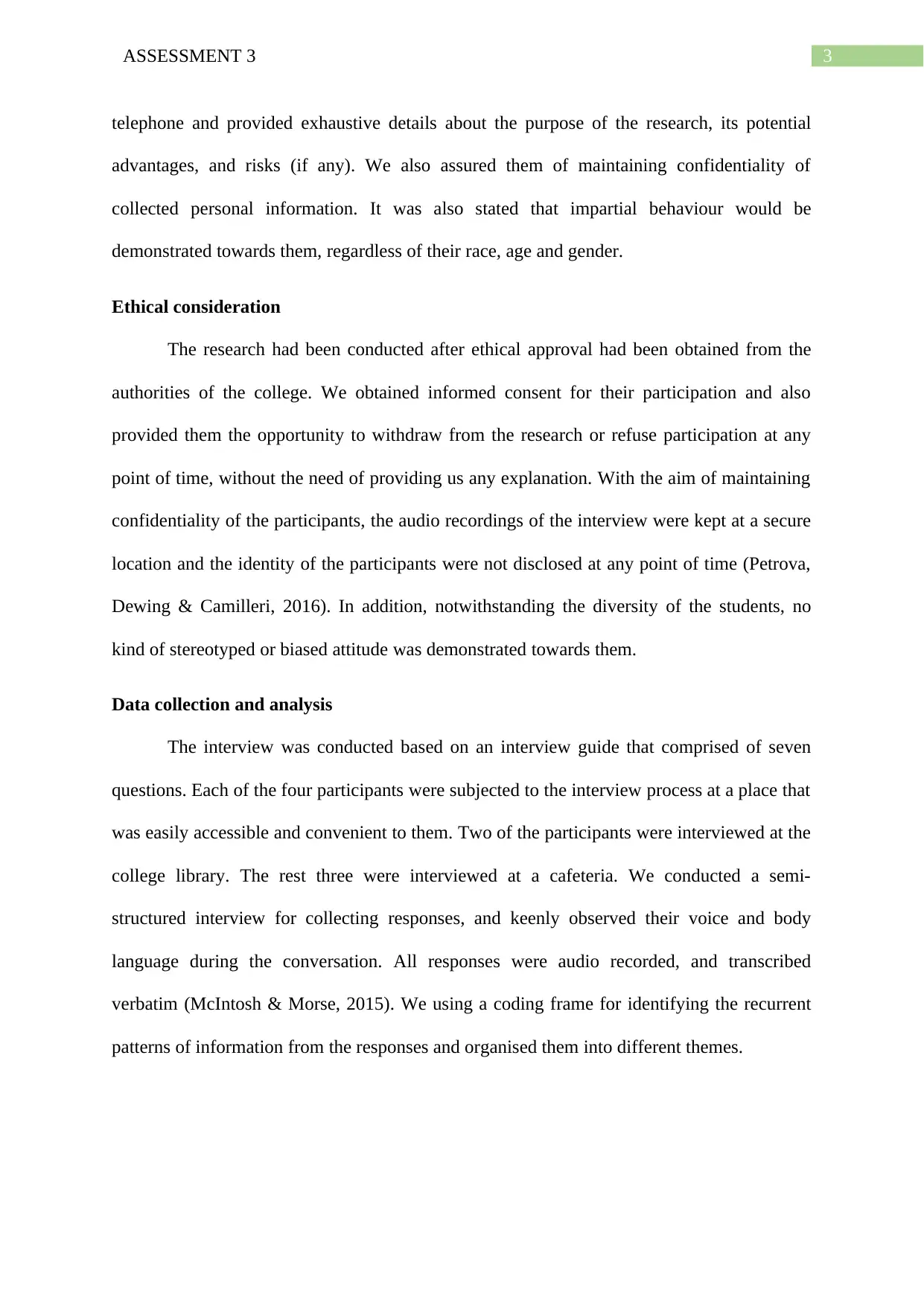
3ASSESSMENT 3
telephone and provided exhaustive details about the purpose of the research, its potential
advantages, and risks (if any). We also assured them of maintaining confidentiality of
collected personal information. It was also stated that impartial behaviour would be
demonstrated towards them, regardless of their race, age and gender.
Ethical consideration
The research had been conducted after ethical approval had been obtained from the
authorities of the college. We obtained informed consent for their participation and also
provided them the opportunity to withdraw from the research or refuse participation at any
point of time, without the need of providing us any explanation. With the aim of maintaining
confidentiality of the participants, the audio recordings of the interview were kept at a secure
location and the identity of the participants were not disclosed at any point of time (Petrova,
Dewing & Camilleri, 2016). In addition, notwithstanding the diversity of the students, no
kind of stereotyped or biased attitude was demonstrated towards them.
Data collection and analysis
The interview was conducted based on an interview guide that comprised of seven
questions. Each of the four participants were subjected to the interview process at a place that
was easily accessible and convenient to them. Two of the participants were interviewed at the
college library. The rest three were interviewed at a cafeteria. We conducted a semi-
structured interview for collecting responses, and keenly observed their voice and body
language during the conversation. All responses were audio recorded, and transcribed
verbatim (McIntosh & Morse, 2015). We using a coding frame for identifying the recurrent
patterns of information from the responses and organised them into different themes.
telephone and provided exhaustive details about the purpose of the research, its potential
advantages, and risks (if any). We also assured them of maintaining confidentiality of
collected personal information. It was also stated that impartial behaviour would be
demonstrated towards them, regardless of their race, age and gender.
Ethical consideration
The research had been conducted after ethical approval had been obtained from the
authorities of the college. We obtained informed consent for their participation and also
provided them the opportunity to withdraw from the research or refuse participation at any
point of time, without the need of providing us any explanation. With the aim of maintaining
confidentiality of the participants, the audio recordings of the interview were kept at a secure
location and the identity of the participants were not disclosed at any point of time (Petrova,
Dewing & Camilleri, 2016). In addition, notwithstanding the diversity of the students, no
kind of stereotyped or biased attitude was demonstrated towards them.
Data collection and analysis
The interview was conducted based on an interview guide that comprised of seven
questions. Each of the four participants were subjected to the interview process at a place that
was easily accessible and convenient to them. Two of the participants were interviewed at the
college library. The rest three were interviewed at a cafeteria. We conducted a semi-
structured interview for collecting responses, and keenly observed their voice and body
language during the conversation. All responses were audio recorded, and transcribed
verbatim (McIntosh & Morse, 2015). We using a coding frame for identifying the recurrent
patterns of information from the responses and organised them into different themes.
Paraphrase This Document
Need a fresh take? Get an instant paraphrase of this document with our AI Paraphraser
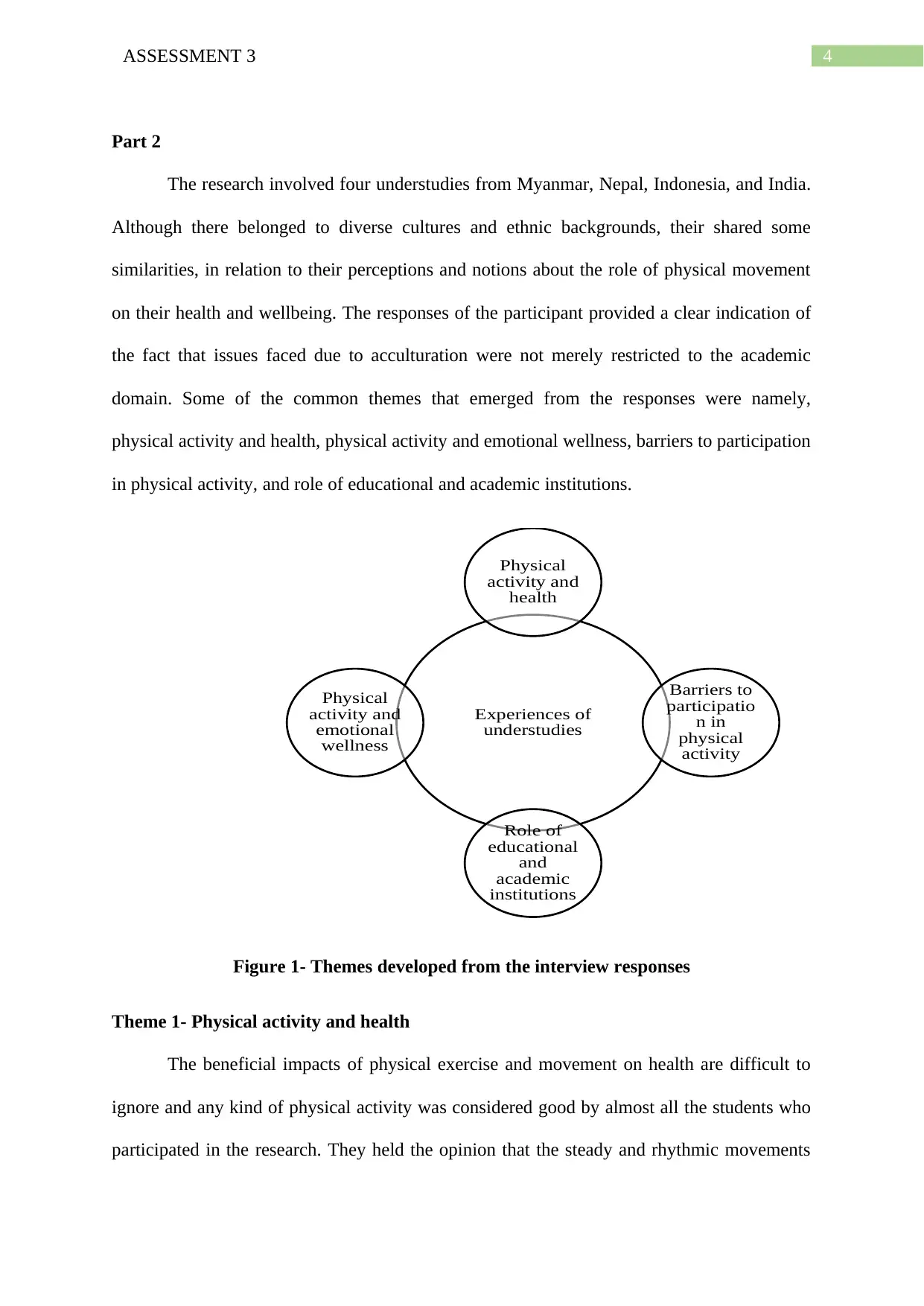
4ASSESSMENT 3
Part 2
The research involved four understudies from Myanmar, Nepal, Indonesia, and India.
Although there belonged to diverse cultures and ethnic backgrounds, their shared some
similarities, in relation to their perceptions and notions about the role of physical movement
on their health and wellbeing. The responses of the participant provided a clear indication of
the fact that issues faced due to acculturation were not merely restricted to the academic
domain. Some of the common themes that emerged from the responses were namely,
physical activity and health, physical activity and emotional wellness, barriers to participation
in physical activity, and role of educational and academic institutions.
Figure 1- Themes developed from the interview responses
Theme 1- Physical activity and health
The beneficial impacts of physical exercise and movement on health are difficult to
ignore and any kind of physical activity was considered good by almost all the students who
participated in the research. They held the opinion that the steady and rhythmic movements
Experiences of
understudies
Physical
activity and
health
Barriers to
participatio
n in
physical
activity
Role of
educational
and
academic
institutions
Physical
activity and
emotional
wellness
Part 2
The research involved four understudies from Myanmar, Nepal, Indonesia, and India.
Although there belonged to diverse cultures and ethnic backgrounds, their shared some
similarities, in relation to their perceptions and notions about the role of physical movement
on their health and wellbeing. The responses of the participant provided a clear indication of
the fact that issues faced due to acculturation were not merely restricted to the academic
domain. Some of the common themes that emerged from the responses were namely,
physical activity and health, physical activity and emotional wellness, barriers to participation
in physical activity, and role of educational and academic institutions.
Figure 1- Themes developed from the interview responses
Theme 1- Physical activity and health
The beneficial impacts of physical exercise and movement on health are difficult to
ignore and any kind of physical activity was considered good by almost all the students who
participated in the research. They held the opinion that the steady and rhythmic movements
Experiences of
understudies
Physical
activity and
health
Barriers to
participatio
n in
physical
activity
Role of
educational
and
academic
institutions
Physical
activity and
emotional
wellness
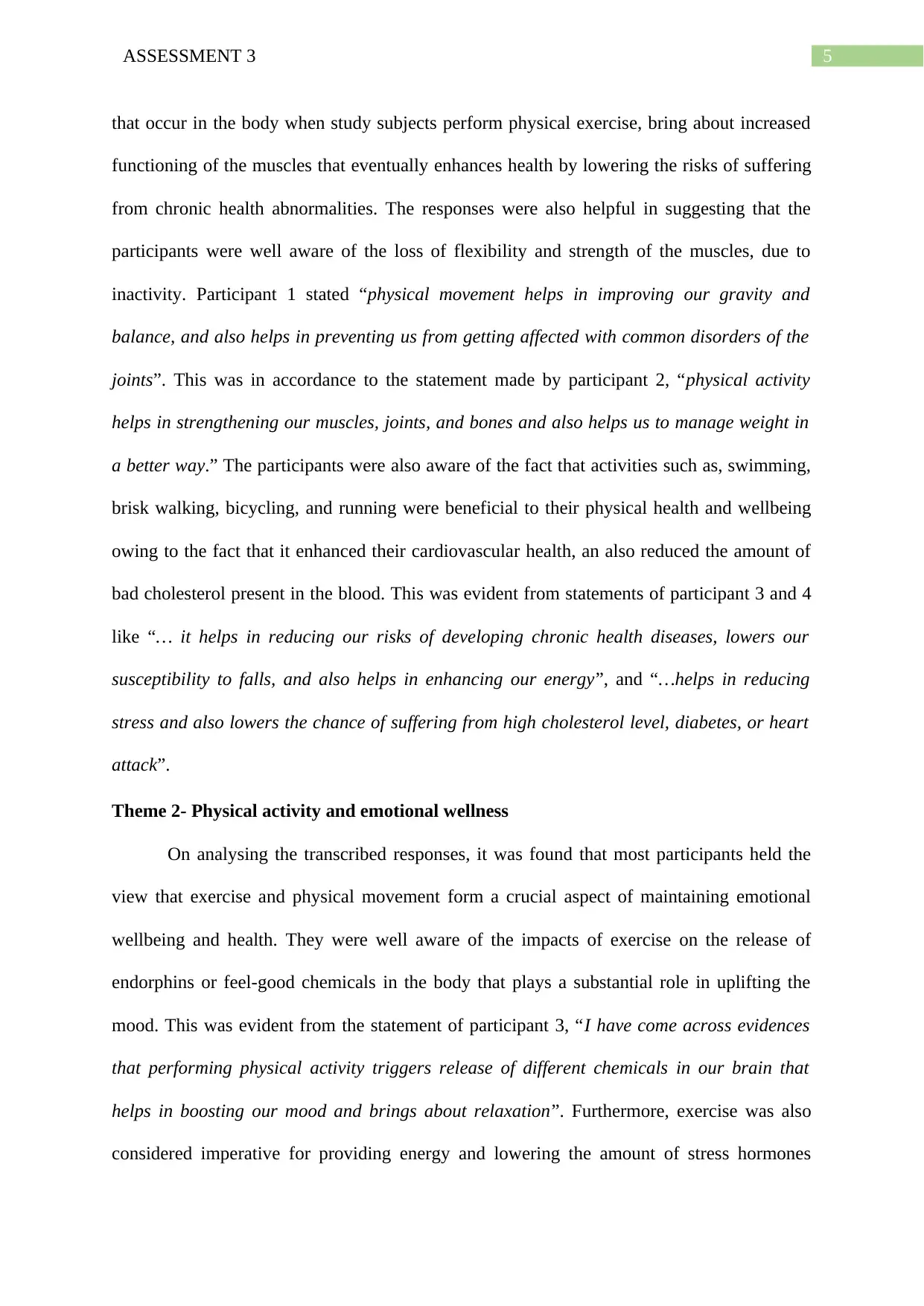
5ASSESSMENT 3
that occur in the body when study subjects perform physical exercise, bring about increased
functioning of the muscles that eventually enhances health by lowering the risks of suffering
from chronic health abnormalities. The responses were also helpful in suggesting that the
participants were well aware of the loss of flexibility and strength of the muscles, due to
inactivity. Participant 1 stated “physical movement helps in improving our gravity and
balance, and also helps in preventing us from getting affected with common disorders of the
joints”. This was in accordance to the statement made by participant 2, “physical activity
helps in strengthening our muscles, joints, and bones and also helps us to manage weight in
a better way.” The participants were also aware of the fact that activities such as, swimming,
brisk walking, bicycling, and running were beneficial to their physical health and wellbeing
owing to the fact that it enhanced their cardiovascular health, an also reduced the amount of
bad cholesterol present in the blood. This was evident from statements of participant 3 and 4
like “… it helps in reducing our risks of developing chronic health diseases, lowers our
susceptibility to falls, and also helps in enhancing our energy”, and “…helps in reducing
stress and also lowers the chance of suffering from high cholesterol level, diabetes, or heart
attack”.
Theme 2- Physical activity and emotional wellness
On analysing the transcribed responses, it was found that most participants held the
view that exercise and physical movement form a crucial aspect of maintaining emotional
wellbeing and health. They were well aware of the impacts of exercise on the release of
endorphins or feel-good chemicals in the body that plays a substantial role in uplifting the
mood. This was evident from the statement of participant 3, “I have come across evidences
that performing physical activity triggers release of different chemicals in our brain that
helps in boosting our mood and brings about relaxation”. Furthermore, exercise was also
considered imperative for providing energy and lowering the amount of stress hormones
that occur in the body when study subjects perform physical exercise, bring about increased
functioning of the muscles that eventually enhances health by lowering the risks of suffering
from chronic health abnormalities. The responses were also helpful in suggesting that the
participants were well aware of the loss of flexibility and strength of the muscles, due to
inactivity. Participant 1 stated “physical movement helps in improving our gravity and
balance, and also helps in preventing us from getting affected with common disorders of the
joints”. This was in accordance to the statement made by participant 2, “physical activity
helps in strengthening our muscles, joints, and bones and also helps us to manage weight in
a better way.” The participants were also aware of the fact that activities such as, swimming,
brisk walking, bicycling, and running were beneficial to their physical health and wellbeing
owing to the fact that it enhanced their cardiovascular health, an also reduced the amount of
bad cholesterol present in the blood. This was evident from statements of participant 3 and 4
like “… it helps in reducing our risks of developing chronic health diseases, lowers our
susceptibility to falls, and also helps in enhancing our energy”, and “…helps in reducing
stress and also lowers the chance of suffering from high cholesterol level, diabetes, or heart
attack”.
Theme 2- Physical activity and emotional wellness
On analysing the transcribed responses, it was found that most participants held the
view that exercise and physical movement form a crucial aspect of maintaining emotional
wellbeing and health. They were well aware of the impacts of exercise on the release of
endorphins or feel-good chemicals in the body that plays a substantial role in uplifting the
mood. This was evident from the statement of participant 3, “I have come across evidences
that performing physical activity triggers release of different chemicals in our brain that
helps in boosting our mood and brings about relaxation”. Furthermore, exercise was also
considered imperative for providing energy and lowering the amount of stress hormones
⊘ This is a preview!⊘
Do you want full access?
Subscribe today to unlock all pages.

Trusted by 1+ million students worldwide
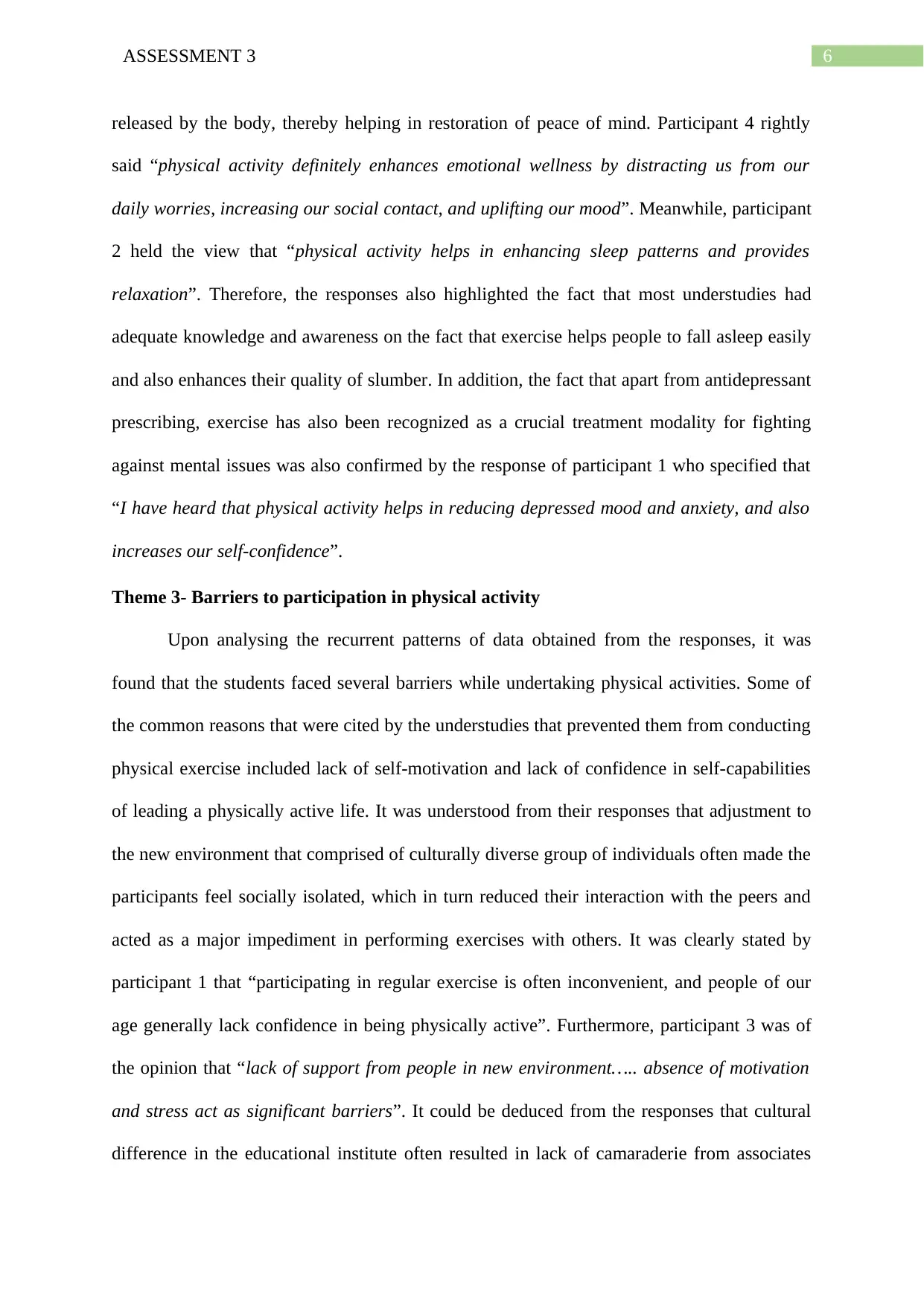
6ASSESSMENT 3
released by the body, thereby helping in restoration of peace of mind. Participant 4 rightly
said “physical activity definitely enhances emotional wellness by distracting us from our
daily worries, increasing our social contact, and uplifting our mood”. Meanwhile, participant
2 held the view that “physical activity helps in enhancing sleep patterns and provides
relaxation”. Therefore, the responses also highlighted the fact that most understudies had
adequate knowledge and awareness on the fact that exercise helps people to fall asleep easily
and also enhances their quality of slumber. In addition, the fact that apart from antidepressant
prescribing, exercise has also been recognized as a crucial treatment modality for fighting
against mental issues was also confirmed by the response of participant 1 who specified that
“I have heard that physical activity helps in reducing depressed mood and anxiety, and also
increases our self-confidence”.
Theme 3- Barriers to participation in physical activity
Upon analysing the recurrent patterns of data obtained from the responses, it was
found that the students faced several barriers while undertaking physical activities. Some of
the common reasons that were cited by the understudies that prevented them from conducting
physical exercise included lack of self-motivation and lack of confidence in self-capabilities
of leading a physically active life. It was understood from their responses that adjustment to
the new environment that comprised of culturally diverse group of individuals often made the
participants feel socially isolated, which in turn reduced their interaction with the peers and
acted as a major impediment in performing exercises with others. It was clearly stated by
participant 1 that “participating in regular exercise is often inconvenient, and people of our
age generally lack confidence in being physically active”. Furthermore, participant 3 was of
the opinion that “lack of support from people in new environment….. absence of motivation
and stress act as significant barriers”. It could be deduced from the responses that cultural
difference in the educational institute often resulted in lack of camaraderie from associates
released by the body, thereby helping in restoration of peace of mind. Participant 4 rightly
said “physical activity definitely enhances emotional wellness by distracting us from our
daily worries, increasing our social contact, and uplifting our mood”. Meanwhile, participant
2 held the view that “physical activity helps in enhancing sleep patterns and provides
relaxation”. Therefore, the responses also highlighted the fact that most understudies had
adequate knowledge and awareness on the fact that exercise helps people to fall asleep easily
and also enhances their quality of slumber. In addition, the fact that apart from antidepressant
prescribing, exercise has also been recognized as a crucial treatment modality for fighting
against mental issues was also confirmed by the response of participant 1 who specified that
“I have heard that physical activity helps in reducing depressed mood and anxiety, and also
increases our self-confidence”.
Theme 3- Barriers to participation in physical activity
Upon analysing the recurrent patterns of data obtained from the responses, it was
found that the students faced several barriers while undertaking physical activities. Some of
the common reasons that were cited by the understudies that prevented them from conducting
physical exercise included lack of self-motivation and lack of confidence in self-capabilities
of leading a physically active life. It was understood from their responses that adjustment to
the new environment that comprised of culturally diverse group of individuals often made the
participants feel socially isolated, which in turn reduced their interaction with the peers and
acted as a major impediment in performing exercises with others. It was clearly stated by
participant 1 that “participating in regular exercise is often inconvenient, and people of our
age generally lack confidence in being physically active”. Furthermore, participant 3 was of
the opinion that “lack of support from people in new environment….. absence of motivation
and stress act as significant barriers”. It could be deduced from the responses that cultural
difference in the educational institute often resulted in lack of camaraderie from associates
Paraphrase This Document
Need a fresh take? Get an instant paraphrase of this document with our AI Paraphraser
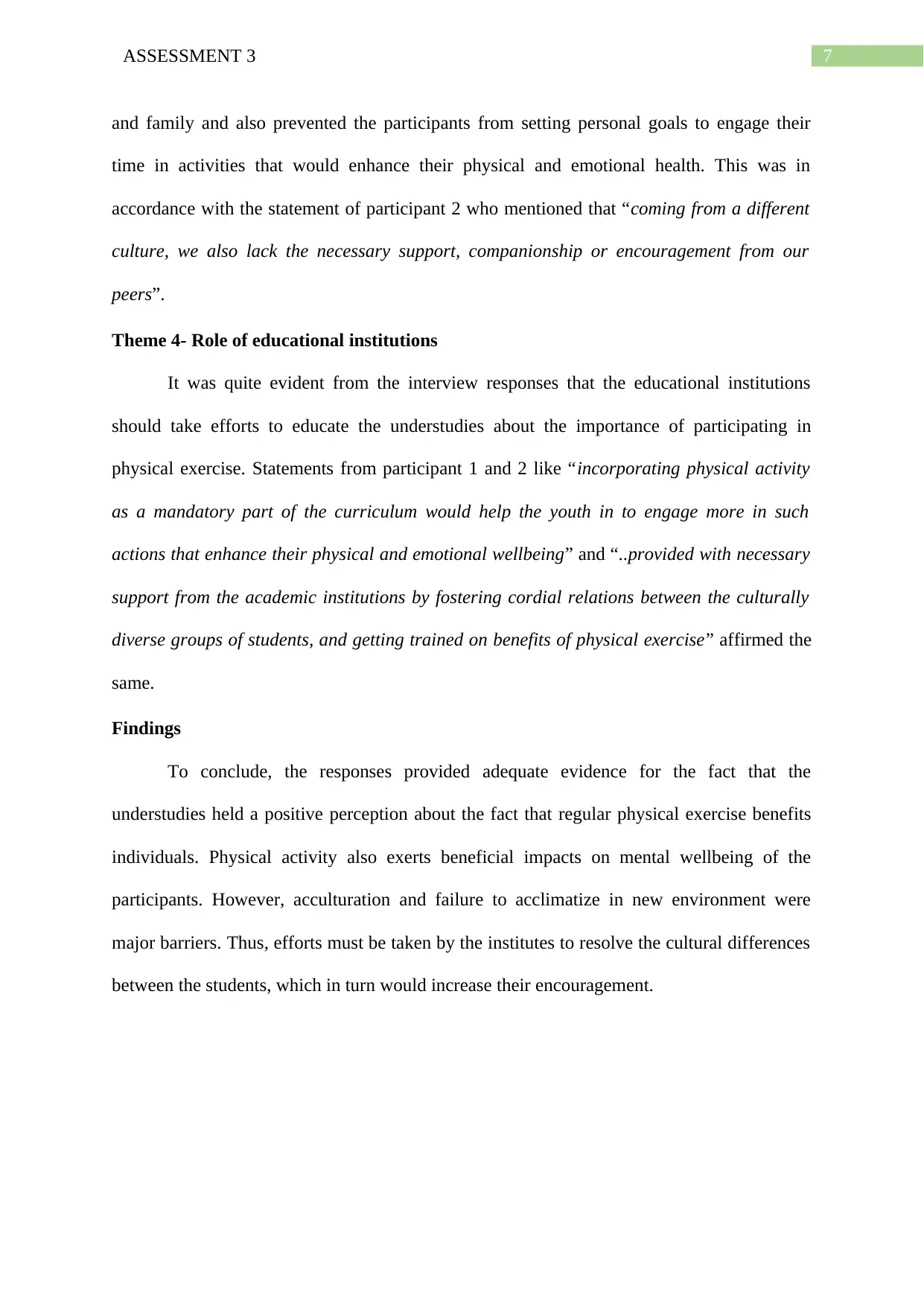
7ASSESSMENT 3
and family and also prevented the participants from setting personal goals to engage their
time in activities that would enhance their physical and emotional health. This was in
accordance with the statement of participant 2 who mentioned that “coming from a different
culture, we also lack the necessary support, companionship or encouragement from our
peers”.
Theme 4- Role of educational institutions
It was quite evident from the interview responses that the educational institutions
should take efforts to educate the understudies about the importance of participating in
physical exercise. Statements from participant 1 and 2 like “incorporating physical activity
as a mandatory part of the curriculum would help the youth in to engage more in such
actions that enhance their physical and emotional wellbeing” and “..provided with necessary
support from the academic institutions by fostering cordial relations between the culturally
diverse groups of students, and getting trained on benefits of physical exercise” affirmed the
same.
Findings
To conclude, the responses provided adequate evidence for the fact that the
understudies held a positive perception about the fact that regular physical exercise benefits
individuals. Physical activity also exerts beneficial impacts on mental wellbeing of the
participants. However, acculturation and failure to acclimatize in new environment were
major barriers. Thus, efforts must be taken by the institutes to resolve the cultural differences
between the students, which in turn would increase their encouragement.
and family and also prevented the participants from setting personal goals to engage their
time in activities that would enhance their physical and emotional health. This was in
accordance with the statement of participant 2 who mentioned that “coming from a different
culture, we also lack the necessary support, companionship or encouragement from our
peers”.
Theme 4- Role of educational institutions
It was quite evident from the interview responses that the educational institutions
should take efforts to educate the understudies about the importance of participating in
physical exercise. Statements from participant 1 and 2 like “incorporating physical activity
as a mandatory part of the curriculum would help the youth in to engage more in such
actions that enhance their physical and emotional wellbeing” and “..provided with necessary
support from the academic institutions by fostering cordial relations between the culturally
diverse groups of students, and getting trained on benefits of physical exercise” affirmed the
same.
Findings
To conclude, the responses provided adequate evidence for the fact that the
understudies held a positive perception about the fact that regular physical exercise benefits
individuals. Physical activity also exerts beneficial impacts on mental wellbeing of the
participants. However, acculturation and failure to acclimatize in new environment were
major barriers. Thus, efforts must be taken by the institutes to resolve the cultural differences
between the students, which in turn would increase their encouragement.
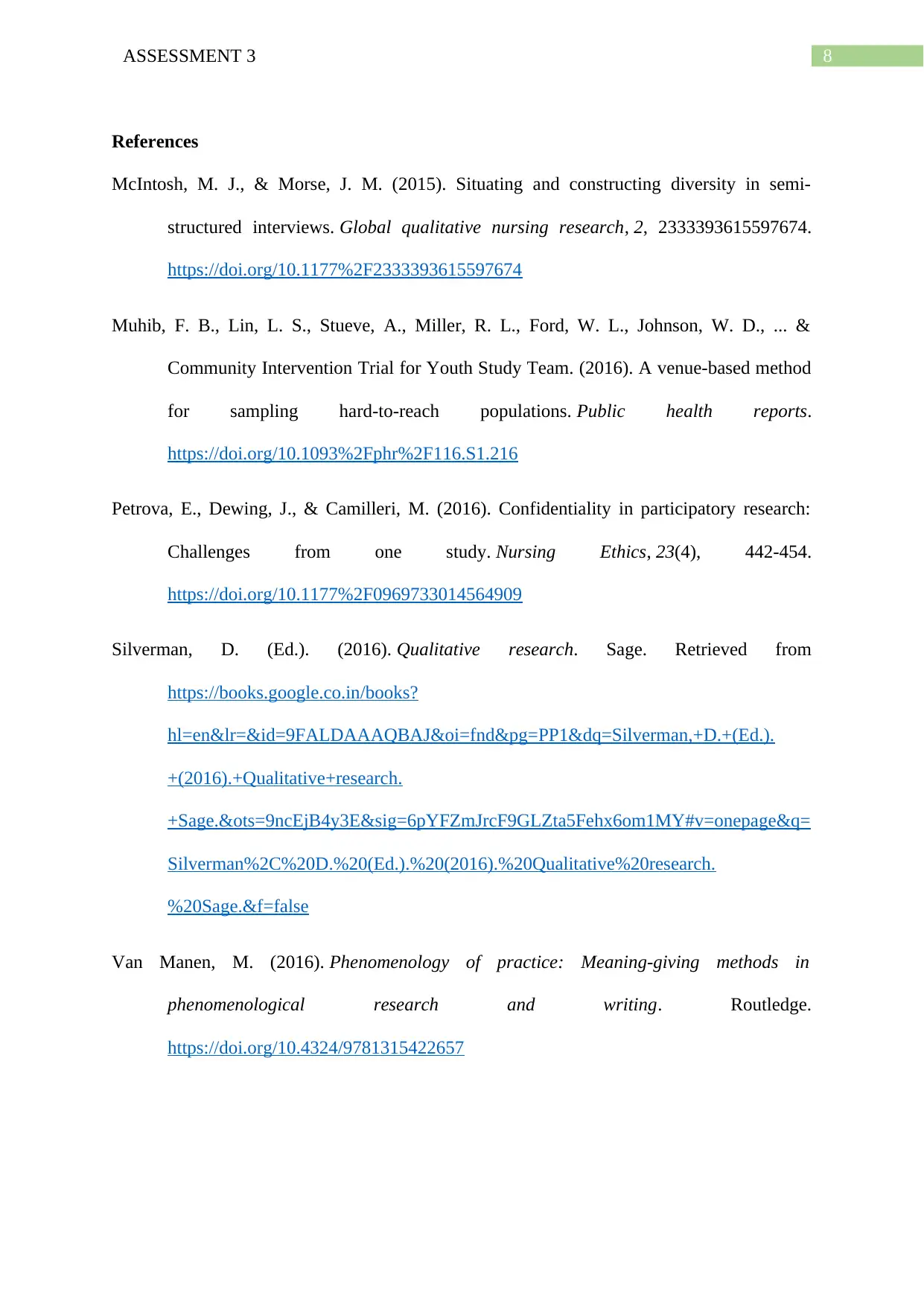
8ASSESSMENT 3
References
McIntosh, M. J., & Morse, J. M. (2015). Situating and constructing diversity in semi-
structured interviews. Global qualitative nursing research, 2, 2333393615597674.
https://doi.org/10.1177%2F2333393615597674
Muhib, F. B., Lin, L. S., Stueve, A., Miller, R. L., Ford, W. L., Johnson, W. D., ... &
Community Intervention Trial for Youth Study Team. (2016). A venue-based method
for sampling hard-to-reach populations. Public health reports.
https://doi.org/10.1093%2Fphr%2F116.S1.216
Petrova, E., Dewing, J., & Camilleri, M. (2016). Confidentiality in participatory research:
Challenges from one study. Nursing Ethics, 23(4), 442-454.
https://doi.org/10.1177%2F0969733014564909
Silverman, D. (Ed.). (2016). Qualitative research. Sage. Retrieved from
https://books.google.co.in/books?
hl=en&lr=&id=9FALDAAAQBAJ&oi=fnd&pg=PP1&dq=Silverman,+D.+(Ed.).
+(2016).+Qualitative+research.
+Sage.&ots=9ncEjB4y3E&sig=6pYFZmJrcF9GLZta5Fehx6om1MY#v=onepage&q=
Silverman%2C%20D.%20(Ed.).%20(2016).%20Qualitative%20research.
%20Sage.&f=false
Van Manen, M. (2016). Phenomenology of practice: Meaning-giving methods in
phenomenological research and writing. Routledge.
https://doi.org/10.4324/9781315422657
References
McIntosh, M. J., & Morse, J. M. (2015). Situating and constructing diversity in semi-
structured interviews. Global qualitative nursing research, 2, 2333393615597674.
https://doi.org/10.1177%2F2333393615597674
Muhib, F. B., Lin, L. S., Stueve, A., Miller, R. L., Ford, W. L., Johnson, W. D., ... &
Community Intervention Trial for Youth Study Team. (2016). A venue-based method
for sampling hard-to-reach populations. Public health reports.
https://doi.org/10.1093%2Fphr%2F116.S1.216
Petrova, E., Dewing, J., & Camilleri, M. (2016). Confidentiality in participatory research:
Challenges from one study. Nursing Ethics, 23(4), 442-454.
https://doi.org/10.1177%2F0969733014564909
Silverman, D. (Ed.). (2016). Qualitative research. Sage. Retrieved from
https://books.google.co.in/books?
hl=en&lr=&id=9FALDAAAQBAJ&oi=fnd&pg=PP1&dq=Silverman,+D.+(Ed.).
+(2016).+Qualitative+research.
+Sage.&ots=9ncEjB4y3E&sig=6pYFZmJrcF9GLZta5Fehx6om1MY#v=onepage&q=
Silverman%2C%20D.%20(Ed.).%20(2016).%20Qualitative%20research.
%20Sage.&f=false
Van Manen, M. (2016). Phenomenology of practice: Meaning-giving methods in
phenomenological research and writing. Routledge.
https://doi.org/10.4324/9781315422657
⊘ This is a preview!⊘
Do you want full access?
Subscribe today to unlock all pages.

Trusted by 1+ million students worldwide
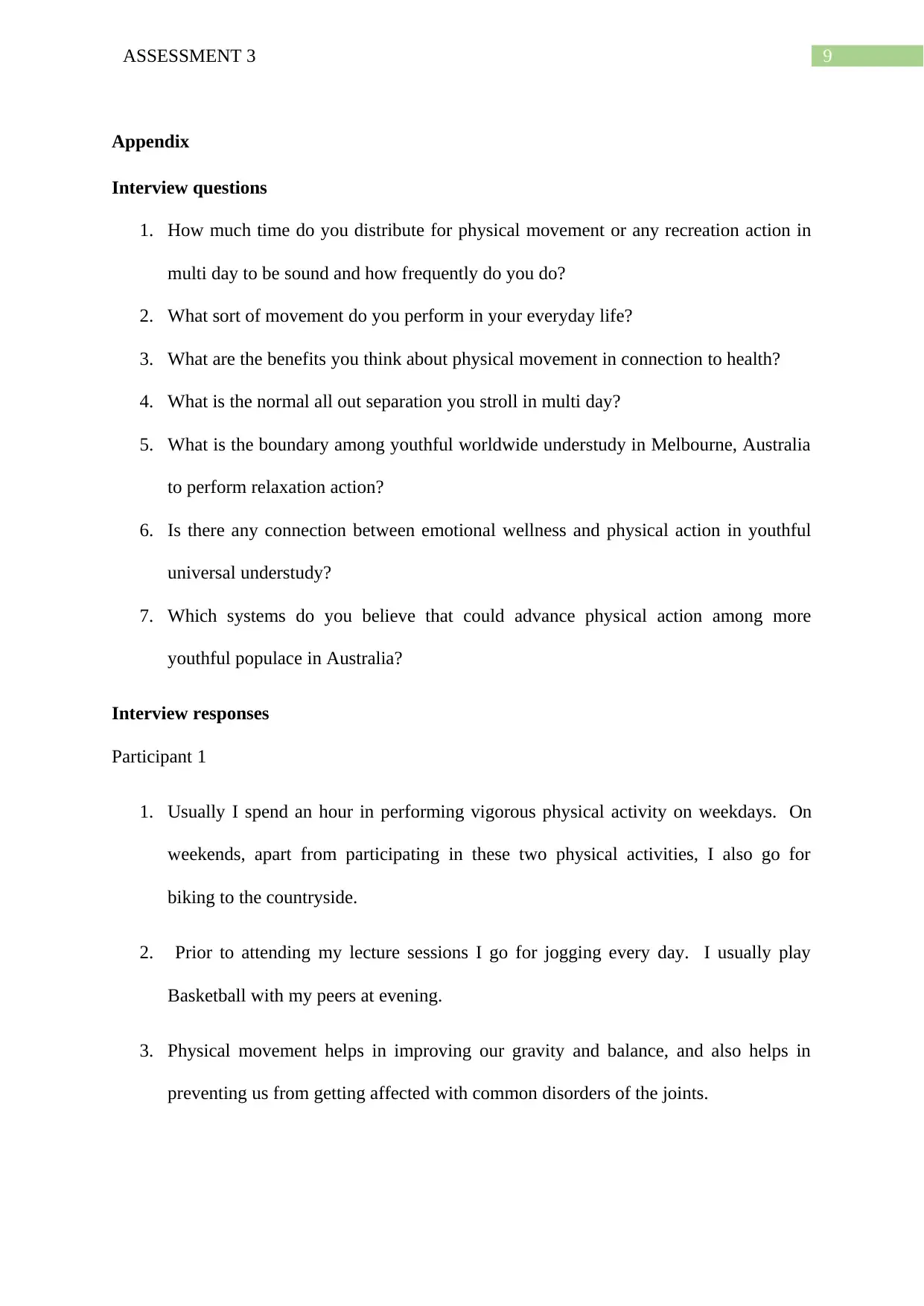
9ASSESSMENT 3
Appendix
Interview questions
1. How much time do you distribute for physical movement or any recreation action in
multi day to be sound and how frequently do you do?
2. What sort of movement do you perform in your everyday life?
3. What are the benefits you think about physical movement in connection to health?
4. What is the normal all out separation you stroll in multi day?
5. What is the boundary among youthful worldwide understudy in Melbourne, Australia
to perform relaxation action?
6. Is there any connection between emotional wellness and physical action in youthful
universal understudy?
7. Which systems do you believe that could advance physical action among more
youthful populace in Australia?
Interview responses
Participant 1
1. Usually I spend an hour in performing vigorous physical activity on weekdays. On
weekends, apart from participating in these two physical activities, I also go for
biking to the countryside.
2. Prior to attending my lecture sessions I go for jogging every day. I usually play
Basketball with my peers at evening.
3. Physical movement helps in improving our gravity and balance, and also helps in
preventing us from getting affected with common disorders of the joints.
Appendix
Interview questions
1. How much time do you distribute for physical movement or any recreation action in
multi day to be sound and how frequently do you do?
2. What sort of movement do you perform in your everyday life?
3. What are the benefits you think about physical movement in connection to health?
4. What is the normal all out separation you stroll in multi day?
5. What is the boundary among youthful worldwide understudy in Melbourne, Australia
to perform relaxation action?
6. Is there any connection between emotional wellness and physical action in youthful
universal understudy?
7. Which systems do you believe that could advance physical action among more
youthful populace in Australia?
Interview responses
Participant 1
1. Usually I spend an hour in performing vigorous physical activity on weekdays. On
weekends, apart from participating in these two physical activities, I also go for
biking to the countryside.
2. Prior to attending my lecture sessions I go for jogging every day. I usually play
Basketball with my peers at evening.
3. Physical movement helps in improving our gravity and balance, and also helps in
preventing us from getting affected with common disorders of the joints.
Paraphrase This Document
Need a fresh take? Get an instant paraphrase of this document with our AI Paraphraser
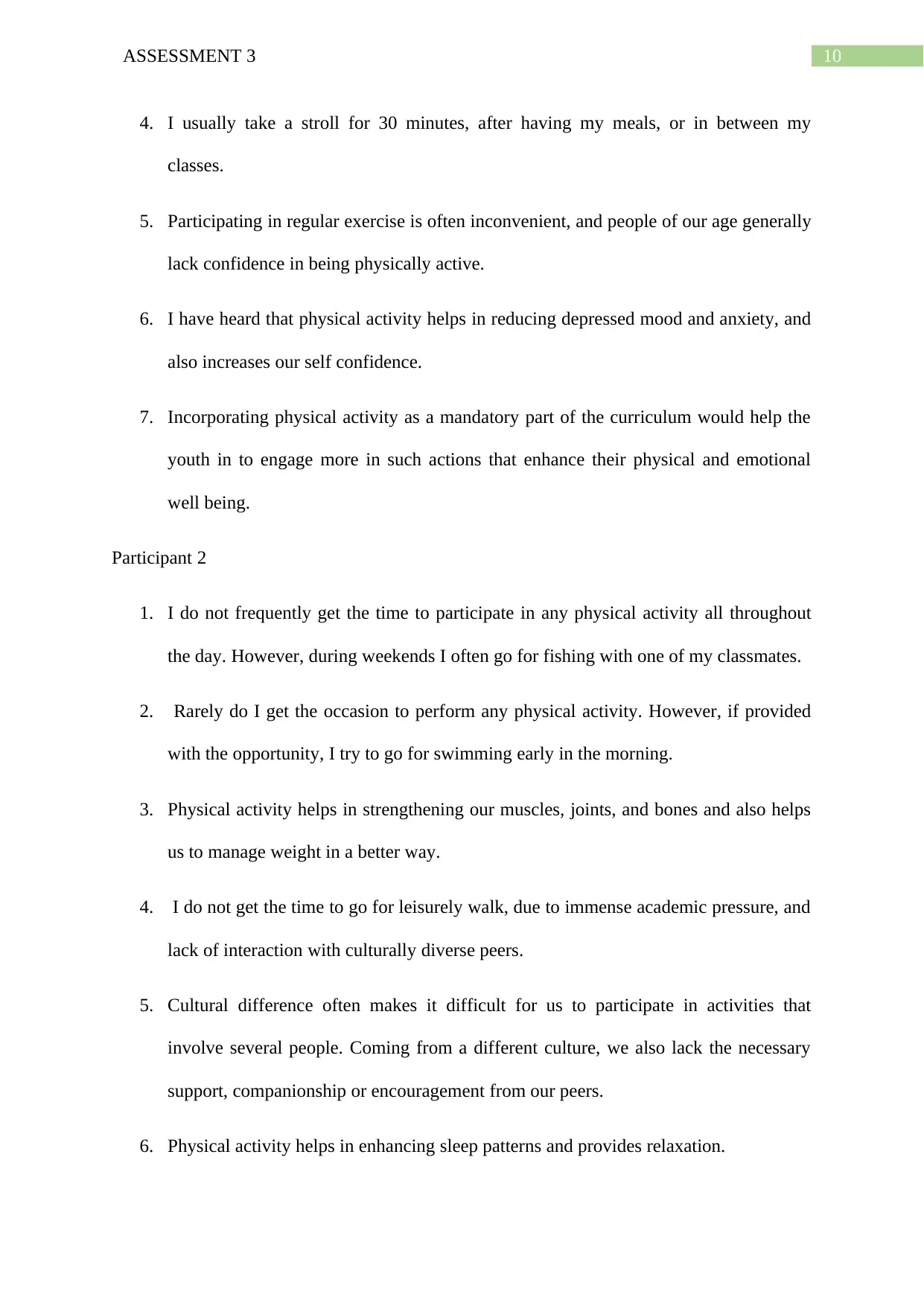
10ASSESSMENT 3
4. I usually take a stroll for 30 minutes, after having my meals, or in between my
classes.
5. Participating in regular exercise is often inconvenient, and people of our age generally
lack confidence in being physically active.
6. I have heard that physical activity helps in reducing depressed mood and anxiety, and
also increases our self confidence.
7. Incorporating physical activity as a mandatory part of the curriculum would help the
youth in to engage more in such actions that enhance their physical and emotional
well being.
Participant 2
1. I do not frequently get the time to participate in any physical activity all throughout
the day. However, during weekends I often go for fishing with one of my classmates.
2. Rarely do I get the occasion to perform any physical activity. However, if provided
with the opportunity, I try to go for swimming early in the morning.
3. Physical activity helps in strengthening our muscles, joints, and bones and also helps
us to manage weight in a better way.
4. I do not get the time to go for leisurely walk, due to immense academic pressure, and
lack of interaction with culturally diverse peers.
5. Cultural difference often makes it difficult for us to participate in activities that
involve several people. Coming from a different culture, we also lack the necessary
support, companionship or encouragement from our peers.
6. Physical activity helps in enhancing sleep patterns and provides relaxation.
4. I usually take a stroll for 30 minutes, after having my meals, or in between my
classes.
5. Participating in regular exercise is often inconvenient, and people of our age generally
lack confidence in being physically active.
6. I have heard that physical activity helps in reducing depressed mood and anxiety, and
also increases our self confidence.
7. Incorporating physical activity as a mandatory part of the curriculum would help the
youth in to engage more in such actions that enhance their physical and emotional
well being.
Participant 2
1. I do not frequently get the time to participate in any physical activity all throughout
the day. However, during weekends I often go for fishing with one of my classmates.
2. Rarely do I get the occasion to perform any physical activity. However, if provided
with the opportunity, I try to go for swimming early in the morning.
3. Physical activity helps in strengthening our muscles, joints, and bones and also helps
us to manage weight in a better way.
4. I do not get the time to go for leisurely walk, due to immense academic pressure, and
lack of interaction with culturally diverse peers.
5. Cultural difference often makes it difficult for us to participate in activities that
involve several people. Coming from a different culture, we also lack the necessary
support, companionship or encouragement from our peers.
6. Physical activity helps in enhancing sleep patterns and provides relaxation.
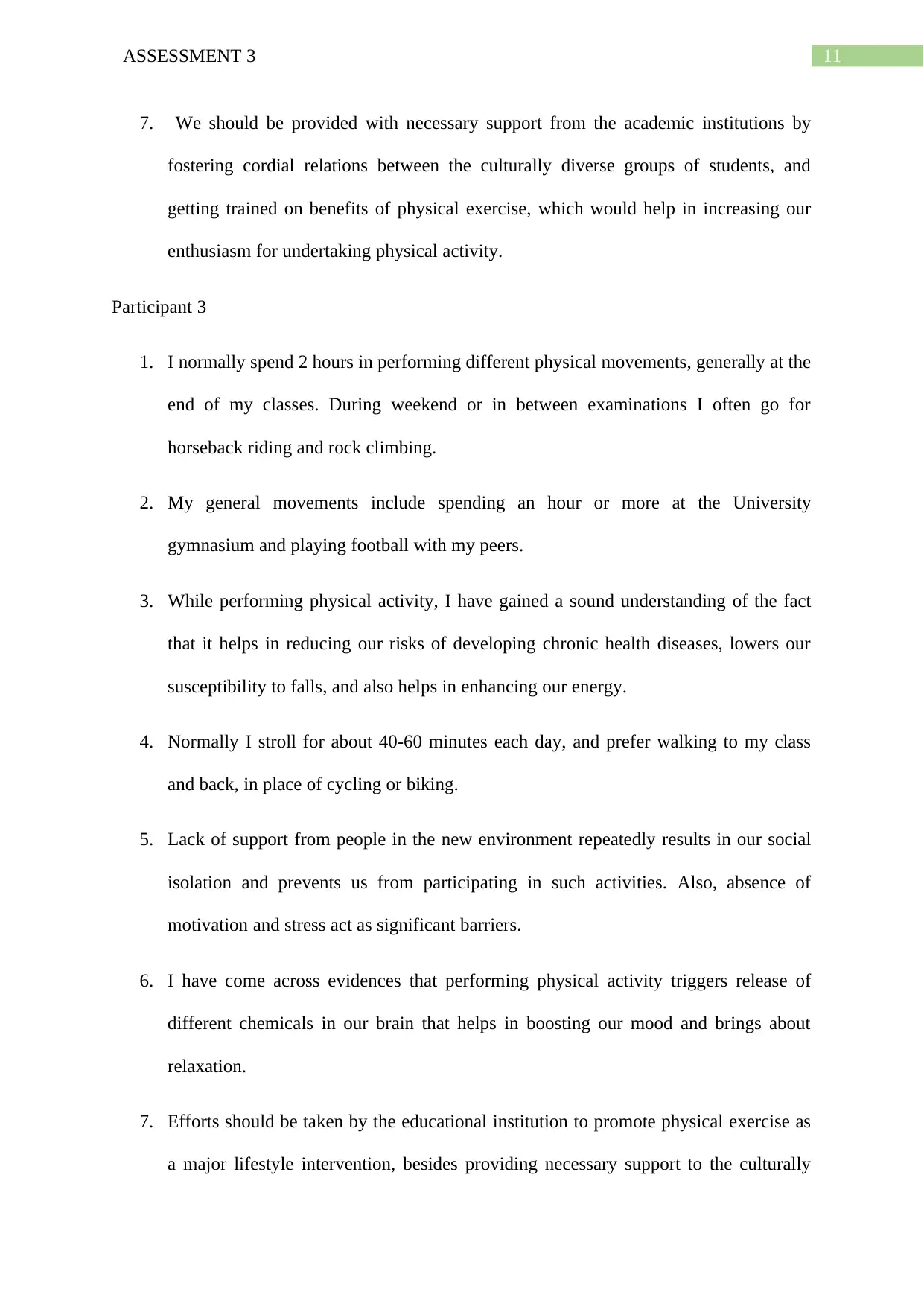
11ASSESSMENT 3
7. We should be provided with necessary support from the academic institutions by
fostering cordial relations between the culturally diverse groups of students, and
getting trained on benefits of physical exercise, which would help in increasing our
enthusiasm for undertaking physical activity.
Participant 3
1. I normally spend 2 hours in performing different physical movements, generally at the
end of my classes. During weekend or in between examinations I often go for
horseback riding and rock climbing.
2. My general movements include spending an hour or more at the University
gymnasium and playing football with my peers.
3. While performing physical activity, I have gained a sound understanding of the fact
that it helps in reducing our risks of developing chronic health diseases, lowers our
susceptibility to falls, and also helps in enhancing our energy.
4. Normally I stroll for about 40-60 minutes each day, and prefer walking to my class
and back, in place of cycling or biking.
5. Lack of support from people in the new environment repeatedly results in our social
isolation and prevents us from participating in such activities. Also, absence of
motivation and stress act as significant barriers.
6. I have come across evidences that performing physical activity triggers release of
different chemicals in our brain that helps in boosting our mood and brings about
relaxation.
7. Efforts should be taken by the educational institution to promote physical exercise as
a major lifestyle intervention, besides providing necessary support to the culturally
7. We should be provided with necessary support from the academic institutions by
fostering cordial relations between the culturally diverse groups of students, and
getting trained on benefits of physical exercise, which would help in increasing our
enthusiasm for undertaking physical activity.
Participant 3
1. I normally spend 2 hours in performing different physical movements, generally at the
end of my classes. During weekend or in between examinations I often go for
horseback riding and rock climbing.
2. My general movements include spending an hour or more at the University
gymnasium and playing football with my peers.
3. While performing physical activity, I have gained a sound understanding of the fact
that it helps in reducing our risks of developing chronic health diseases, lowers our
susceptibility to falls, and also helps in enhancing our energy.
4. Normally I stroll for about 40-60 minutes each day, and prefer walking to my class
and back, in place of cycling or biking.
5. Lack of support from people in the new environment repeatedly results in our social
isolation and prevents us from participating in such activities. Also, absence of
motivation and stress act as significant barriers.
6. I have come across evidences that performing physical activity triggers release of
different chemicals in our brain that helps in boosting our mood and brings about
relaxation.
7. Efforts should be taken by the educational institution to promote physical exercise as
a major lifestyle intervention, besides providing necessary support to the culturally
⊘ This is a preview!⊘
Do you want full access?
Subscribe today to unlock all pages.

Trusted by 1+ million students worldwide
1 out of 13
Related Documents
Your All-in-One AI-Powered Toolkit for Academic Success.
+13062052269
info@desklib.com
Available 24*7 on WhatsApp / Email
![[object Object]](/_next/static/media/star-bottom.7253800d.svg)
Unlock your academic potential
Copyright © 2020–2025 A2Z Services. All Rights Reserved. Developed and managed by ZUCOL.





